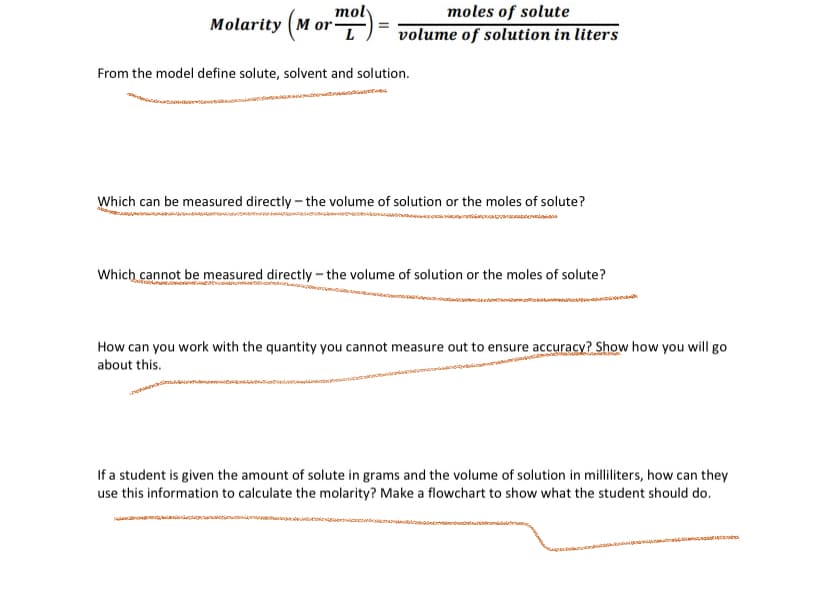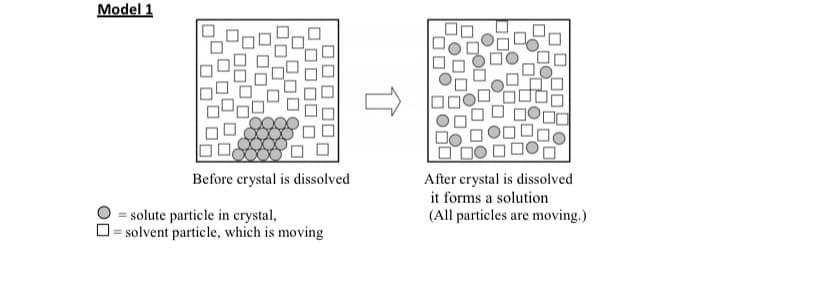From the model define solute, solvent and solution. Which can be measured directly- the volume of solution or the moles of solute? Which cannot be measured directly- the volume of solution or the moles of solute? How can you work with the quantity you cannot measure out to ensure accuracy? Show how you will go about this.
From the model define solute, solvent and solution. Which can be measured directly- the volume of solution or the moles of solute? Which cannot be measured directly- the volume of solution or the moles of solute? How can you work with the quantity you cannot measure out to ensure accuracy? Show how you will go about this.
Chemistry by OpenStax (2015-05-04)
1st Edition
ISBN:9781938168390
Author:Klaus Theopold, Richard H Langley, Paul Flowers, William R. Robinson, Mark Blaser
Publisher:Klaus Theopold, Richard H Langley, Paul Flowers, William R. Robinson, Mark Blaser
Chapter11: Solutions And Colloids
Section: Chapter Questions
Problem 73E: How do colloids differ from solutions with regard to dispersed particle size and homogeneity?
Related questions
Question

Transcribed Image Text:moly
moles of solute
Molarity (M or"
L
volume of solution in liters
From the model define solute, solvent and solution.
Which can be measured directly – the volume of solution or the moles of solute?
al
Which cannot be measured directly - the volume of solution or the moles of solute?
How can you work with the quantity you cannot measure out to ensure accuracy? Show how you will go
about this.
If a student is given the amount of solute in grams and the volume of solution in milliliters, how can they
use this information to calculate the molarity? Make a flowchart to show what the student should do.

Transcribed Image Text:Model 1
Before crystal is dissolved
After crystal is dissolved
it forms a solution
(All particles are moving.)
= solute particle in crystal,
O= solvent particle, which is moving
OL
Expert Solution
This question has been solved!
Explore an expertly crafted, step-by-step solution for a thorough understanding of key concepts.
Step by step
Solved in 2 steps

Knowledge Booster
Learn more about
Need a deep-dive on the concept behind this application? Look no further. Learn more about this topic, chemistry and related others by exploring similar questions and additional content below.Recommended textbooks for you

Chemistry by OpenStax (2015-05-04)
Chemistry
ISBN:
9781938168390
Author:
Klaus Theopold, Richard H Langley, Paul Flowers, William R. Robinson, Mark Blaser
Publisher:
OpenStax

Principles of Modern Chemistry
Chemistry
ISBN:
9781305079113
Author:
David W. Oxtoby, H. Pat Gillis, Laurie J. Butler
Publisher:
Cengage Learning


Chemistry by OpenStax (2015-05-04)
Chemistry
ISBN:
9781938168390
Author:
Klaus Theopold, Richard H Langley, Paul Flowers, William R. Robinson, Mark Blaser
Publisher:
OpenStax

Principles of Modern Chemistry
Chemistry
ISBN:
9781305079113
Author:
David W. Oxtoby, H. Pat Gillis, Laurie J. Butler
Publisher:
Cengage Learning


Chemistry for Today: General, Organic, and Bioche…
Chemistry
ISBN:
9781305960060
Author:
Spencer L. Seager, Michael R. Slabaugh, Maren S. Hansen
Publisher:
Cengage Learning


Introductory Chemistry: A Foundation
Chemistry
ISBN:
9781337399425
Author:
Steven S. Zumdahl, Donald J. DeCoste
Publisher:
Cengage Learning